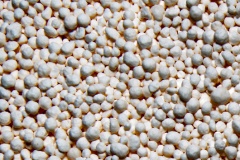Difference between revisions of "Calcium Ammonium Nitrate"
m (→Risk Factors) |
|||
| Line 19: | Line 19: | ||
==Risk Factors== | ==Risk Factors== | ||
* Moisture damage | * Moisture damage | ||
| − | * Oxidizer, fire risk in | + | * Oxidizer, fire risk in contact with organic material<br><br> |
Note: | Note: | ||
CAN may be dangerous for human health. Avoid to swallow or contact with mucous membranes, eyes and repeated contact with skin. Dust of the fertilizer is irritable and may cause an oversensitiveness or eczemas. During manipulation it is necessary to protect the skin and eyes, eating, drinking and smoking are not allowed. After the work hands should be washed thoroughly and regeneration cream should be used. Keep out of reach of children and unauthorised persons. | CAN may be dangerous for human health. Avoid to swallow or contact with mucous membranes, eyes and repeated contact with skin. Dust of the fertilizer is irritable and may cause an oversensitiveness or eczemas. During manipulation it is necessary to protect the skin and eyes, eating, drinking and smoking are not allowed. After the work hands should be washed thoroughly and regeneration cream should be used. Keep out of reach of children and unauthorised persons. | ||
Latest revision as of 11:10, 12 January 2021
| Infobox on Calcium Ammonium Nitrate | |
|---|---|
| Example of Calcium Ammonium Nitrate |  |
| Facts | |
| Origin | - |
| Stowage factor (in m3/t) | 0,9 m3/ft (bulk) |
| Humidity / moisture | 1% |
| Ventilation | - |
| Risk factors | - |
Calcium Ammonium Nitrate
Contents
Description / Application
Calcium Ammonium Nitrate, often abbreviated CAN, is a fertilizer which is a blend of about 20%-30% CaCO3 and 70%-80% Ammonium nitrate. It may also have a small percentage of calcium nitrate in it.
It contains nitrogen in both the ammoniacal and the nitric forms to provide plant nutrition during the whole growing period.
Calcium ammonium nitrate is a mixture (fuse) of ammonium nitrate and ground limestone. The product is physiologically neutral. It is manufactured in granular form (in size varying from 1 to 5 mm) and suitable for mixing with phosphate and potassium fertilizers. In comparison with ammonium nitrate CAN has better physical-chemical properties, less water-absorbing and caking as well as it can be stored in stacks.
Calcium ammonium nitrate can be used for all kinds of soil and for all types of agricultural crops as the main, presowing fertilizer and for top dressing. Under systematic use the fertilizer doesn’t acidify soil and supplies plants with calcium and magnesium. It is the most efficient in case of acidic and sodic soils and soils with light granulometric composition.
Shipment / Storage
Calcium ammonium nitrate is delivered in bulk, on pallets per 1,200 kg (24 bags per 50 kg) fixed by a PE foil, or in big-bags (500-1000 kg).
Should be stored under cover.
Bituminised paper bags used in the shipment of this commodity to the Far East have not always proved satisfactory in the prevention of moisture absorption.
Risk Factors
- Moisture damage
- Oxidizer, fire risk in contact with organic material
Note:
CAN may be dangerous for human health. Avoid to swallow or contact with mucous membranes, eyes and repeated contact with skin. Dust of the fertilizer is irritable and may cause an oversensitiveness or eczemas. During manipulation it is necessary to protect the skin and eyes, eating, drinking and smoking are not allowed. After the work hands should be washed thoroughly and regeneration cream should be used. Keep out of reach of children and unauthorised persons.
Reference is made to the relevant IMO regulations on hazardous cargo. See also MSDS sheet(s).











